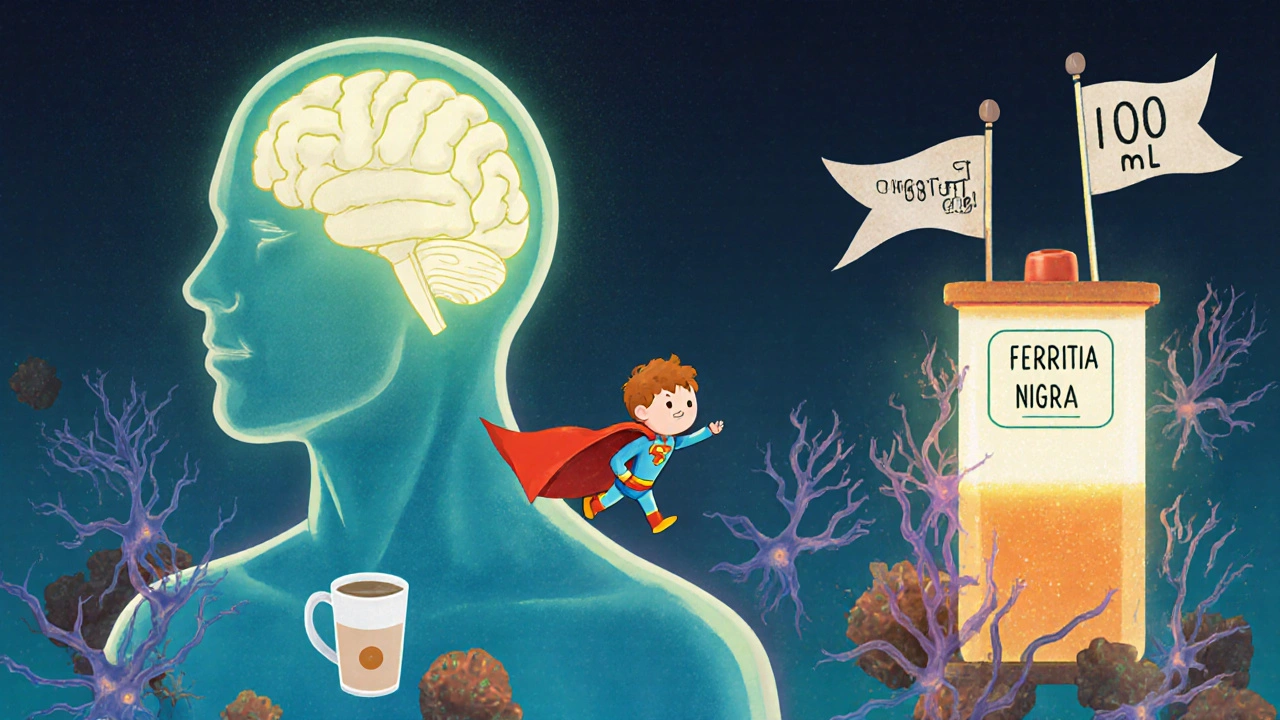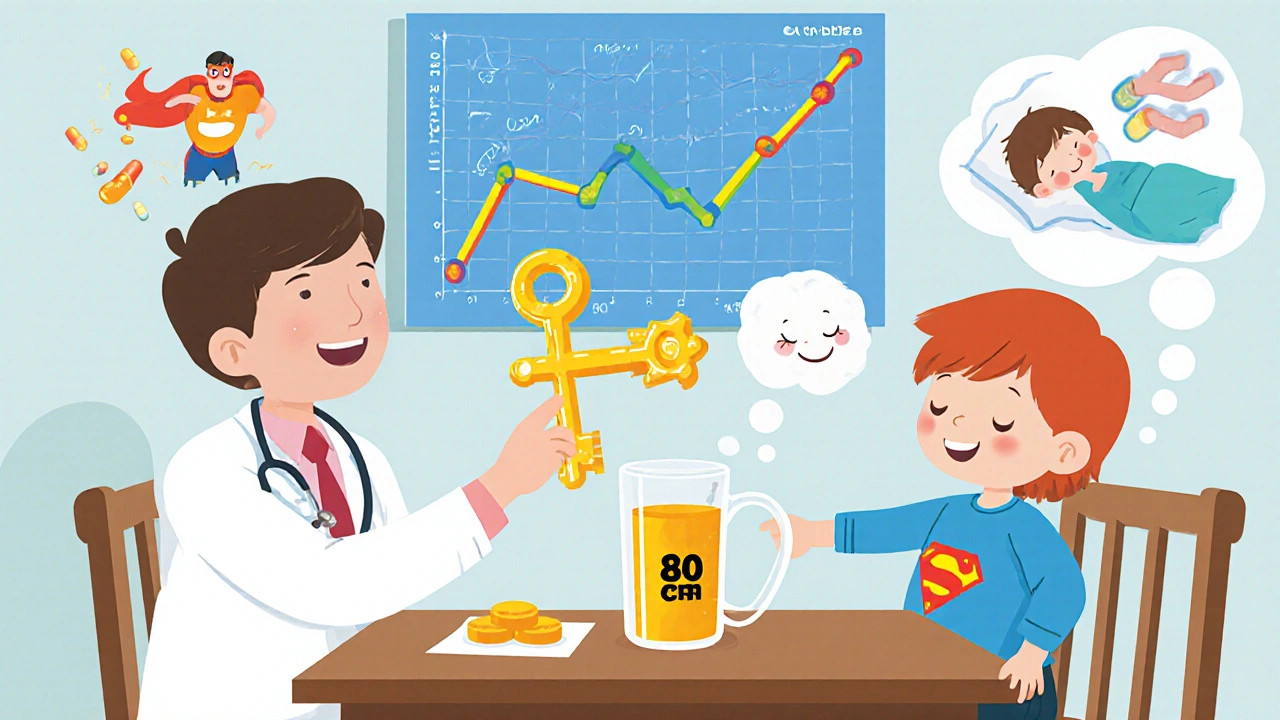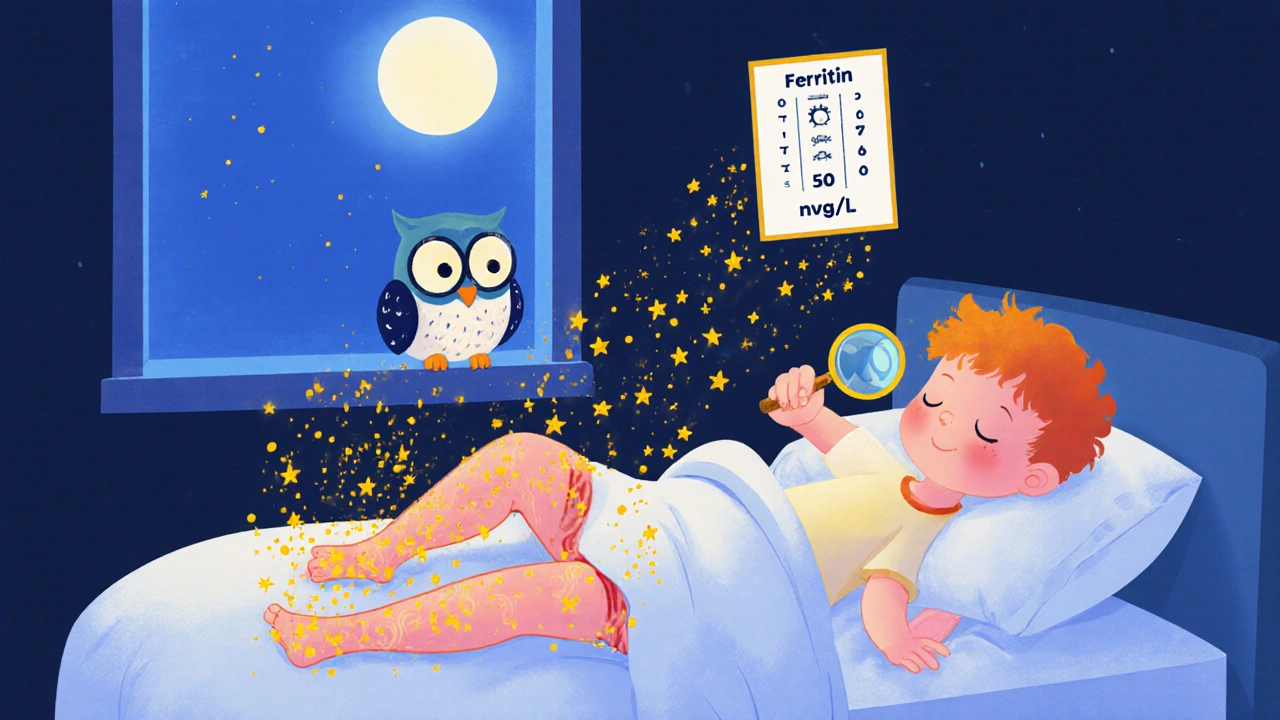If you’ve ever lain awake at night with an unbearable urge to move your legs-like something’s crawling under your skin, or your muscles are buzzing with tension-you’re not alone. Restless Legs Syndrome (RLS), also called Willis-Ekbom Disease, affects 5 to 10% of adults in the U.S. and Europe. And while many assume it’s just stress or bad sleep habits, the real culprit for many is something deeper: low iron in the brain. Not your blood iron. Not your overall iron. But the iron your brain needs to function properly. That’s where ferritin comes in.
Why Ferritin Matters More Than Your Blood Iron
Most doctors check your serum iron or hemoglobin when you’re tired or sluggish. But for RLS, those numbers can look perfectly normal-even while your brain is starving for iron. That’s because RLS isn’t about total body iron. It’s about iron in the substantia nigra, a tiny area deep in the brain that controls movement. When this region lacks iron, nerve signals go haywire. That’s what creates the creepy-crawly feeling and the uncontrollable need to move.
Ferritin is the storage form of iron. It’s the best marker we have to estimate how much iron your brain has access to. And here’s the hard truth: if your ferritin is below 50 ng/mL, you’re at high risk for moderate to severe RLS symptoms. Even if your doctor says your iron is "normal" (12-300 ng/mL), that range is too broad for RLS. The cutoff isn’t 12. It’s 50.
Studies from the American Academy of Neurology, the American Academy of Sleep Medicine, and Johns Hopkins all agree: ferritin under 50 ng/mL is a treatable cause of RLS. In fact, correcting this deficiency can cut symptoms in half for about half of all patients. And unlike medications, it doesn’t make things worse over time.
The Problem with Dopamine Pills
Most people with RLS are prescribed dopamine agonists like pramipexole or ropinirole. They work fast-sometimes in days. But they come with a dangerous catch: augmentation.
Augmentation means your symptoms get worse, not better. They start earlier in the day. Spread to your arms. Become more intense. And the only way to fix it? Increase the dose. Which makes it worse. Up to 80% of long-term users end up with this problem, according to the Journal of Clinical Sleep Medicine. After 10 years on these drugs, some patients are taking triple the original dose just to stay functional.
Iron therapy doesn’t do that. There’s no known risk of augmentation. No tolerance buildup. No withdrawal. Just a slow, steady fix to the root problem.
What Ferritin Level Should You Aim For?
It’s not enough to just get ferritin above 50. That’s the minimum. The real target? 75 to 100 ng/mL.
Why? Because studies show that patients with ferritin in this range have the best symptom control. One 2019 study in the Journal of Clinical Sleep Medicine found that people with ferritin above 75 ng/mL had significantly fewer nighttime awakenings and less daytime fatigue. Another study showed that patients who reached 100 ng/mL were 65% more likely to stay symptom-free for over two years.
That’s why top sleep specialists now recommend treating ferritin to 75-100 ng/mL-not just 50. Think of it like filling a gas tank. You don’t stop when the needle hits E. You fill it to half or three-quarters so you don’t run out before the next stop.

Oral Iron: How to Take It Right
If your ferritin is below 50 ng/mL, your doctor should recommend oral iron. The standard dose is 325 mg of ferrous sulfate once daily. That gives you 65 mg of elemental iron-more than most multivitamins contain.
But here’s the catch: most people take it wrong. Ferrous sulfate is best absorbed on an empty stomach. But that’s when it causes nausea, constipation, or stomach cramps. About 28% of people quit because of side effects.
Here’s what actually works:
- Take it with 100-200 mg of vitamin C (like a glass of orange juice or a supplement). Vitamin C boosts absorption by up to 30%.
- If your stomach can’t handle daily dosing, try every other day. Research in Blood Advances shows this maintains effectiveness while cutting side effects in half.
- Avoid calcium, antacids, coffee, or tea within two hours. They block iron absorption.
- Wait at least four weeks before expecting results. It takes time for your brain to rebuild its iron stores.
Don’t switch brands or doses without testing. Many over-the-counter supplements contain less than 20 mg of elemental iron-way too low to fix RLS.
When Oral Iron Isn’t Enough
Some people absorb iron poorly. Others have gut issues like IBS or celiac disease. Some have high hepcidin-a hormone that blocks iron from entering cells. If your ferritin stays below 30 ng/mL after 3 months of proper oral iron, you need IV iron.
IV iron, like ferric carboxymaltose, delivers 1000 mg directly into your bloodstream. One infusion. One visit. No pills. No stomach pain. And it works fast: ferritin jumps an average of 127 ng/mL within six weeks. In one major trial, 68% of patients saw their RLS symptoms cut in half after just one IV dose.
It’s not expensive either. A single IV infusion costs about $400-$800, depending on location. Compare that to $2,400-$4,800 per year for dopamine pills. And you’re not risking augmentation.
Diet Alone Won’t Fix It
You might think, "I’ll just eat more red meat." But that won’t cut it. A 4-ounce steak gives you about 1-2 mg of absorbable iron. To match one ferrous sulfate tablet, you’d need to eat 30 steaks a month. Even with spinach, lentils, or fortified cereals, plant-based iron is poorly absorbed-especially if you have high hepcidin, which is common in RLS.
Supplements are necessary. Diet is supportive, not curative.

What About New Treatments?
There’s promising research on newer iron forms. Liposomal iron and ferric maltol are designed to be gentler on the stomach and better absorbed. Early results show 40% higher absorption and 60% fewer side effects than ferrous sulfate. These aren’t widely available yet, but clinical trials are ongoing. If you’ve struggled with oral iron, ask your doctor if you qualify for one.
Also, new guidelines are coming. The American Academy of Sleep Medicine is expected to update its 2022 recommendations in early 2025 to recommend IV iron as a first-line option for anyone with ferritin under 75 ng/mL. That’s a big shift-and it’s backed by data from a 342-patient trial showing IV iron outperformed oral iron in both speed and symptom relief.
What to Do Next
If you have RLS, here’s your action plan:
- Ask your doctor for a ferritin test. Don’t settle for just serum iron or hemoglobin.
- If ferritin is below 75 ng/mL, request iron therapy-not dopamine pills.
- If ferritin is below 50 ng/mL, start oral iron with vitamin C (325 mg ferrous sulfate daily or every other day).
- If you can’t tolerate oral iron or ferritin stays low after 3 months, ask about IV iron.
- Re-test ferritin after 8-12 weeks. Target 75-100 ng/mL.
- Track your symptoms. Use a simple scale: 0 = no symptoms, 10 = unbearable. Write it down weekly.
Don’t wait for your doctor to bring it up. Most general practitioners don’t know the ferritin threshold for RLS. You have to ask. And if they say "your iron is normal," ask: "Is it above 50 ng/mL?" If they don’t know, find a sleep specialist or neurologist who does.
RLS isn’t just annoying. It steals sleep. It wears you down. It makes you feel like you’re losing control of your own body. But if low ferritin is the cause, fixing it doesn’t just help your legs. It gives you back your nights, your energy, and your peace of mind.
Can low iron cause restless legs even if my blood count is normal?
Yes. Restless Legs Syndrome is linked to low iron in the brain, not low blood iron. You can have normal hemoglobin and still have ferritin levels below 50 ng/mL, which is enough to trigger RLS symptoms. Ferritin is the key marker-not your CBC or serum iron.
How long does it take for iron supplements to help with restless legs?
It usually takes 4 to 8 weeks to notice improvement. Some people feel a little better after 2-3 weeks, but full effects take longer because your brain needs time to rebuild its iron stores. Don’t stop too soon. If you’re taking iron correctly, give it at least 8 weeks before deciding if it’s working.
Is IV iron safe for treating restless legs?
Yes, when given under medical supervision. IV iron like ferric carboxymaltose has been used safely in over 100,000 RLS patients. Side effects are rare and usually mild-like temporary joint pain or a metallic taste. Serious reactions are extremely uncommon. It’s far safer than long-term dopamine drugs, which carry a high risk of worsening symptoms over time.
Can I take iron supplements with other medications?
Avoid taking iron with calcium supplements, antacids, or thyroid medications-they block absorption. Take iron at least 2 hours apart. Vitamin C helps, so take it with orange juice or a 100-200 mg supplement. If you’re on Parkinson’s meds or dopamine agonists, iron won’t interfere, but it may reduce your need for them over time.
What if my ferritin is 60 ng/mL? Should I still take iron?
Yes. While 60 is above the 50 ng/mL threshold, studies show that up to 35% of people with ferritin between 50-75 ng/mL still improve with iron therapy. Many sleep specialists now treat anyone under 75 ng/mL, especially if symptoms are moderate to severe. It’s worth a trial-especially if you want to avoid dopamine drugs.
Does caffeine make restless legs worse?
Yes. Caffeine, especially in the afternoon or evening, can worsen RLS symptoms. It stimulates the nervous system and interferes with sleep. Even if you’re taking iron, cutting back on coffee, energy drinks, or chocolate after 2 PM can make a noticeable difference. Alcohol and nicotine also make symptoms worse.
Can I test my ferritin at home?
No reliable at-home test exists yet. Ferritin requires a blood draw and lab analysis. Some companies offer finger-prick tests, but they’re not accurate enough for clinical decisions. Always get ferritin tested through your doctor or a certified lab. Don’t rely on consumer health devices.
Final Thought
Restless Legs Syndrome isn’t a mystery. For a large group of people, it’s a simple iron deficiency in the brain. And fixing it doesn’t require complex pills, expensive devices, or risky treatments. Just the right test, the right dose, and the right follow-up. If you’ve been told your legs are just "nervous" or "stress-related," ask about ferritin. You might be surprised how much better you feel once your brain gets the iron it’s been missing.



Comments (10)
Gary Lam
So let me get this straight - we’ve been giving people dopamine pills like candy for decades, but the real fix is just… iron? Like, the stuff in steak and spinach? My doctor told me to ‘sleep better’ and ‘cut caffeine.’ I’m starting to think my GP’s medical degree is from a cereal box.
Peter Stephen .O
Bro. I had RLS for 7 years. Thought it was anxiety. Tried meditation, yoga, magnesium, CBD gummies - nothing. Then I got my ferritin tested - 28 ng/mL. Started iron with OJ, every other day. 6 weeks later, I slept through the night for the first time since college. Not a miracle. Just science. And yeah, it’s boring as hell compared to fancy pills, but it actually works. Your brain isn’t broken. It’s just hungry.
Andrew Cairney
Wait. So the FDA, Big Pharma, and your doctor are all hiding the truth about iron? This is exactly how they controlled the masses with SSRIs and statins. Ferritin under 50? That’s not a medical threshold - it’s a corporate loophole. They make billions off dopamine drugs. Iron? Can’t patent it. Can’t charge $500 a bottle. Look at the timing - they’re about to update guidelines in 2025. Coincidence? Or is someone finally waking up?
Rob Goldstein
For anyone reading this and thinking ‘I’ll just eat more spinach’ - no. Plant-based iron (non-heme) has ~10% bioavailability vs. 25-35% for heme iron from meat. And if you have elevated hepcidin (common in RLS), your gut literally shuts down iron absorption. Oral ferrous sulfate with vitamin C? That’s the baseline. IV iron isn’t ‘extreme’ - it’s targeted neuro-repletion. You wouldn’t give a diabetic a banana instead of insulin. Don’t treat brain iron deficiency like a dietary preference.
vinod mali
My mom had RLS. Took iron for 3 months. No more pacing at 3am. She said it felt like her legs finally stopped screaming. I told her to ask the doctor. She said ‘he didn’t know what ferritin was.’ So I got the test done myself. Ferritin 42. Started supplements. Now she sleeps like a baby. Just saying - if your legs feel like they’re full of ants, don’t ignore it. Test ferritin. It’s cheap. It’s simple. It changes everything.
Jennie Zhu
It is imperative to underscore the clinical significance of serum ferritin as a biomarker for central nervous system iron availability, particularly within the substantia nigra. While hemoglobin and serum iron levels may remain within standard reference ranges, the neurochemical milieu governing dopaminergic signaling is critically dependent upon adequate iron stores. Consequently, therapeutic intervention targeting ferritin levels ≥75 ng/mL is not merely supportive, but constitutes a pathophysiologically grounded approach to symptom mitigation in Willis-Ekbom Disease.
Kathy Grant
I used to think my restless legs were just… me. Like my body was wired wrong. Like I was broken. But when I found out it was just… missing iron? Like my brain was a phone with a dead battery and everyone kept giving me new chargers that didn’t fit? I cried. Not because it was sad. Because it was so simple. And I wasted 10 years thinking I had to be fixed - when all I needed was a little iron and some patience. You’re not broken. You’re just low on fuel. And that’s okay. You can fix this.
Robert Merril
took iron for 2 weeks and nothing happened so i quit. then i read this and went back. 6 weeks later my legs are chill. vitamin c is key. dont take it with milk or coffee. and dont listen to your doctor if they say your iron is fine. ask if its over 50. if they stare blankly - google a sleep doc. also the iv iron thing is wild. one shot and boom. no more pills. why isnt this the first thing they tell you
Noel Molina Mattinez
you guys are missing the real issue here. ferritin levels are manipulated by the pharmaceutical industry to keep people on dopamine drugs. the real cutoff should be 100 not 50. and iv iron is banned in some countries because it’s too effective. also why do all the studies come from Johns Hopkins? coincidence? i think not. check your blood for glyphosate too. it blocks iron absorption. and don’t trust any doctor who doesn’t know what hepcidin is
Roberta Colombin
Thank you for sharing this. I’ve seen so many people suffer in silence, told it’s just stress or aging. But this - this is real. And it’s fixable. If you’re reading this and you’ve been told your legs are ‘just nerves,’ please don’t give up. Ask for ferritin. Be kind to yourself. Your body isn’t failing you. It’s asking for help. And sometimes, the answer is simpler than we’ve been taught.